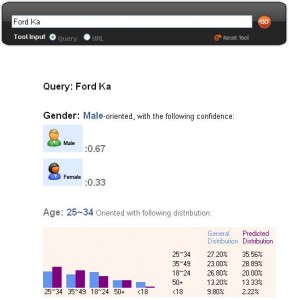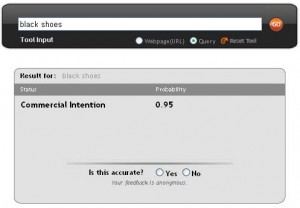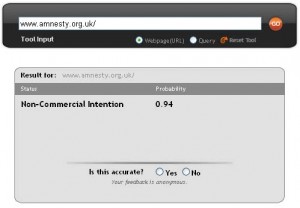![]() For SEOs, online marketers and savvy online business people around the world, Google Adwords, Yahoo! Search Marketing and MSN AdCenter are great places to come to take advantage of some seriously useful marketing data that can turn your marketing heavy club into a hybrid cruise missile rapid marketing attack needle. While Google Adwords may be the standard for search engine marketing, MSN AdCenter has some interesting tools which are worth exploring as they provide some unique options to help to improve your ad exposure to the right people. Amidst the menagerie of tools in AdCenter there is one section called Audience Intelligence which is particularly clever.
For SEOs, online marketers and savvy online business people around the world, Google Adwords, Yahoo! Search Marketing and MSN AdCenter are great places to come to take advantage of some seriously useful marketing data that can turn your marketing heavy club into a hybrid cruise missile rapid marketing attack needle. While Google Adwords may be the standard for search engine marketing, MSN AdCenter has some interesting tools which are worth exploring as they provide some unique options to help to improve your ad exposure to the right people. Amidst the menagerie of tools in AdCenter there is one section called Audience Intelligence which is particularly clever.
Audience Intelligence is a group of tools which are orientated to allow advertisers to improve their online advertising success by “accurately modelling users and predicting their intent”. Knowing more about a user through the sorts of keywords and phrases they type into search engines is a valuable weapon. What people search for is influenced by: their demographic (age, gender etc), the context in which they are searching and the social networks they are a part of. Also, being able to judge a user’s hidden intent based on their search queries and browsing history is another powerful armament.
The following three components of the Audience Intelligence tool help you to discover these important details about your users.
Demographics Prediction
Like the name suggests, this tool predicts what demographic a user is likely to fit into from the keyphrase they input. So if you put in ‘Ford Ka’ you might think that the key demographic for that phrase is 17 year old girls. When in actual fact the results showed that 67% of males between 25-34 searches for ‘Ford Ka’. This prediction is based on the online behaviour captured while people make searches and visit websites. This is a great tool for giving AdCenter advertisers the opportunity to better tailor the keywords they select in order to target their desired audience more accurately.
As you can see, you can also search by URL as well as by search query. The percentage of gender orientation is shown, with handy examples of male and female appearances, and the age distribution is shown at the bottom. The age distribution is an age breakdown of MSN Search users. The General Distribution column is based for each search on one-month search logs and is not dependant on the actual search query. The ‘Predicted Distribution’ column is the same but is tailored to the search query you are researching and AdCenter’s predictive model.
Detecting Online Commercial Intention
Websites in general have three uses: for navigation, as a source of information or as a destination for shopping (transactions). This ‘Detecting Online Commercial Intention’ tool detects, based on the keyword or URL you input, whether people that make this search are looking for information or to make a transaction. (Commercial or non-commercial.) It seems pretty straight forward really: if you typed in ‘black shoes’, the likelihood is that you would only be putting this in if you wanted to buy a pair of black shoes from somewhere. It is less likely that you are researching different coloured shoes, even though you might be, but it would certainly be less likely. ‘Black shoes’ has a 95% commercial intention rate, i.e. Microsoft has found that when someone searches for ‘black shoes’ there is a 95% chance that they are looking to buy some black shoes. Clear enough?
You will notice that they ask you if it is accurate with a ‘yes-no’ check-box. This is what, in the ‘learn more’ section I believe they mean by ‘human evaluators’, though they may well have in house teams too. Here is an example of a non-commercial result for a URL search.
With a little persistence you can use this tool to find keywords that have commercial value but don’t have particularly high ad coverage, so will therefore be cheaper. Finding keywords with a low bid density but high commercial value is an important goal for any PPC advertiser.
Microsoft provides a link to the research they have conducted into commercial/non-commercial user intent in the ‘learn more’ section. It includes some reassuring information to back up their engines results.
Explore MSN
This tool is basically an interactive query manager which analyses a web site’s content and its audience for ad placement and targeting. It lets you specify your search query and the audience you want to reach, then provides you with advice on where in Microsoft’s ad network you should run your ad for best results. So say you want to know where it would be best to run an advert for ‘Rod Stewart tickets’ you can input this in, or the URL of your site, along with your target audience and the Explore MSN tool will provide you with a list of URLs where they think your advert would best perform. The ‘i’ icon can show you information on the audience and the location of the people who view each particular page so you can check you are on the right track.
By letting this tool help you find a location for your advert, you can, if you trust it, cut out a lot of time spent trawling through websites trying to find ones with content similar to that of your site or your search term. Explore MSN can also help you make sure that where you place your ad is the best place for people who are in that area. For example, you could place your ad on a great site that is perfectly suited to your topic and has loads of massive Rod Stewart fans visiting it regularly, but if 99% of these fans come from the other side of the world, there might be little point in placing your ad here.
Conclusion
Audience Intelligence is indeed an impressive range of tools which could seriously improve the success of your online advertising quickly. While each tool in this section is in itself valuable, they are best used in conjunction with each other. Unfortunately for Microsoft though, Google Adwords is still better overall compared to Adcenter, not least of all due to its wider audience. At least one of its rivals ‘Yahoo Search Marketing’ is coming under Microsoft’s wing soon. But then, there is that behemoth in waiting looming nonchalantly on the horizon…Facebook.
Apparently the next tool to be included in the Audience Intelligence segment of AdCenter will be called the ‘Behavioural Targeting System’ which will “create precise, flexible behavioural segments by taking advantage of various data sources, including click stream, search query, and demographic information.” Nice. This will no doubt provide us with an insight into the typical pattern of exploration that users follow, allowing you to use this information to discover where a website might be causing users to leave prematurely, so that you can work to avoid this from happening with better usability and more compelling content.
- Search The Human Body With Google Body Browser - December 21, 2010
- Has This Site Been Hacked? - December 20, 2010
- How Do Twitter & Facebook’s 2010 Trends Compare With Google’s? - December 14, 2010
- Google Zeitgeist 2010: What Have You Been Searching For Planet Earth? - December 10, 2010
- Google Chrome Gets Store And Talks Chrome OS - December 8, 2010
- Google Issues Security Email For Website Optimiser - December 7, 2010
- Google Launches AdWords Global Market Finder - December 7, 2010
- New Android Phone Promises A Pure Experience - December 7, 2010
- Google AdWords Wants Your Products! - December 3, 2010
- Know How Mobile Internet Affects Your Website? Google Analytics does… - December 2, 2010
You may also be interested in:
- PPC Fraudsters and Microsoft Lawsuits Like any big industry, PPC advertising gets it's fair share of scammers and fraudsters. But who's behind it all?...
- New Google Analytics Features – Intelligence Engine Boost Find out your major contributors and get alerts to your email or even by text message... ...
- Ramsay’s Web Wire – Issue #25: Google Wave Diggs its Grave Google Wave gets it's last rights from Google while AdWords might finally get the feature everyone's been waiting for. ...
- Ramsay’s Web Wire – Issue #14: Good and Badvertising ADVERTISING! Ha, got your attention, and after all isn’t that what advertising’s all about. Well there’s probably a bit more...
- Microsoft ‘Patch up’ Internet Explorer In light of the variety of attacks on Google recently, microsoft are set to release the patch today intended to...








